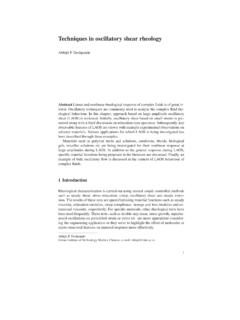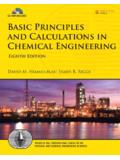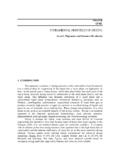Transcription of Non-Newtonian Fluids: An Introduction
1 Non-Newtonian Fluids: An Introduction Chhabra Abstract The objective of this chapter is to introduce and to illustrate the frequent and wide occurrence of Non-Newtonian fluid behaviour in a diverse range of ap- plications, both in nature and in technology. Starting with the definition of a non- newtonian fluid , different types of Non-Newtonian characteristics are briefly de- scribed. Representative examples of materials (foams, suspensions, polymer solu- tions and melts), which, under appropriate circumstances, display shear-thinning, shear-thickening, visco-plastic, time-dependent and visco-elastic behaviour are pre- sented.
2 Each type of Non-Newtonian fluid behaviour has been illustrated via experi- mental data on real materials. This is followed by a short discussion on how to engi- neer Non-Newtonian flow characteristics of a product for its satisfactory end use by manipulating its microstructure by controlling physico-chemical aspects of the sys- tem. Finally, we touch upon the ultimate question about the role of Non-Newtonian characteristics on the analysis and modeling of the processes of pragmatic engineer- ing significance. 1 Introduction Most low molecular weight substances such as organic and inorganic liquids, so- lutions of low molecular weight inorganic salts, molten metals and salts, and gases exhibit newtonian flow characteristics, , at constant temperature and pressure, in simple shear, the shear stress( ) is proportional to the rate of shear ( ) and the constant of proportionality is the familiar dynamic viscosity ( ).
3 Such fluids are classically known as the newtonian fluids, albeit the notion of flow and of viscosity predates Newton [40]. For most liquids, the viscosity decreases with temperature and increases with pressure. For gases, it increases with both temperature and pres- Chhabra Department of Chemical Engineering, Indian Institute of Technology Kanpur e-mail: 1. 2 Chhabra sure [35]. Broadly, higher is the viscosity of a substance, more resistance it presents to flow (and hence more difficult to pump!). Table 1 provides typical values of vis- cosity for scores of common fluids [12]. As we go down in the table, the viscosity increases by several orders of magnitude, and thus one can argue that a solid can be treated as a fluid whose viscosity tends towards infinity.
4 Thus, the dis- tinction between a fluid and a solid is not as sharp as we would like to think! Ever since the formulation of the equations of continuity (mass) and momentum (Cauchy, Navier-Stokes), the fluid dynamics of newtonian fluids has come a long way dur- ing the past 300 or so years, albeit significant challenges especially in the field of turbulence and multi-phase flows still remain. Table 1 Values of viscosity for common fluids at room temperature Substance ( ). Air 10 5. Water 10 3. Ethyl alcohol 10 3. Mercury 10 3. Ethylene glycol 20 10 3. Olive oil 100% Glycerol Honey 10. Corn syrup 100.
5 Bitumen 108. Molten glass 1012. During the past 50-60 years, there has been a growing recognition of the fact that many substances of industrial significance, especially of multi-phase nature (foams, emulsions, dispersions and suspensions, slurries, for instance) and polymeric melts and solutions (both natural and man made) do not conform to the newtonian postu- late of the linear relationship between ( ) and ( ) in simple shear, for instance. Ac- cordingly, these fluids are variously known as Non-Newtonian , non-linear, complex, or rheologically complex fluids. Table 2 gives a representative list of fluids which exhibit different kinds and with varying severity of Non-Newtonian flow behavior [12].
6 Indeed so widespread is the Non-Newtonian fluid behavior in nature and in technology that it would be no exaggeration to say that the newtonian fluid behav- ior is an exception rather than the rule! This chapter endeavours to provide a brief Introduction to the different kinds of Non-Newtonian flow characteristics, their char- acterization and implications in engineering applications. The material presented herein is mainly drawn from our recent books [11, 12]. The assumptions of material isotropy and incompressibility are implicit throughout our discussion. Non-Newtonian Fluids: An Introduction 3.
7 Table 2 Examples of substances exhibiting Non-Newtonian fluid Behaviour Adhesives (wall paper paste, carpet ad- Food stuffs (Fruit/vegetable purees and hesive, for instance) concentrates, sauces, salad dressings, mayonnaise, jams and marmalades, ice- cream, soups, cake mixes and cake top- pings, egg white, bread mixes, snacks). Ales (beer, liqueurs, etc.) Greases and lubricating oils Animal waste slurries from cattle farms Mine tailings and mineral suspensions Biological fluids (blood, synovial fluid , Molten lava and magmas saliva, etc.). Bitumen Paints, polishes and varnishes Cement paste and slurries Paper pulp suspensions Chalk slurries Peat and lignite slurries Chocolates Polymer melts and solutions, reinforced plastics, rubber Coal slurries Printing colors and inks Cosmetics and personal care products Pharmaceutical products (creams, (nail polish, lotions and creams, lipsticks, foams, suspensions, for instance).)
8 Shampoos, shaving foams and creams, toothpaste, etc). Dairy products and dairy waste streams Sewage sludge (cheese, butter, yogurt, fresh cream, whey, for instance). Drilling muds Wet beach sand Fire fighting foams Waxy crude oils 2 Classification of fluid Behavior Definition of a newtonian fluid It is useful to begin with the definition of a newtonian fluid . In simple shear (Fig. 1), the response of a newtonian fluid is characterized by a linear relationship between the applied shear stress and the rate of shear, , F. yx =. = yx (1). A. Fig. 2 shows experimental results for a corn syrup and for a cooking oil confirming their newtonian fluid behavior; the flow curves pass through the origin and the vis- cosity values are = for corn syrup and = 64 for the cooking oil.
9 Fig. 1 and equation (1), of course, represent the simplest case wherein there is only one non-zero component of velocity, Vx , which is a function of y. For the general case of three dimensional flow (Fig. 3), clearly there are six shearing and three nor- mal components of the stress tensor, S. It is customary to split the total stress into an isotropic part (pressure) and a deviatoric part as S = pI + (2). 4 Chhabra Fig. 1 Schematic represen- Surface area, A yx tation of an unidirectional F dVx shearing flow y x Where is traceless, , tr = 0, and pressure is consistent with the conti- Fig. 2 Typical shear stress- shear rate data for two New- 0 10 20 30 40 50 60 70 80.
10 110 550. tonian fluids 100 500. 90 450. 80 400. 70 350. (Pa). 60 300. yx Shear Stress, 50 250. 40 200. 30 150. 20 100. Corn Syrup T=297 K)(. Cooking Oil (T=294 K). 10 50. 0 0. 0 200 400 600 800 1000 1200.. -1. Shear Rate, (s ). yx nuity equation. The tracefree requirement together with the physical requirement of symmetry = T imply that there are only three independent shear components (off-diagonal elements) and two normal stress differences (diagonal elements) of the deviatoric stress. Thus, in Cartesian coordinates, these are xy (= yx ), xz (= zx ), yz (= zy )and the two normal stress differences defined as Primary normal stress difference, N1 = xx yy (3).






